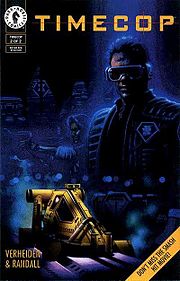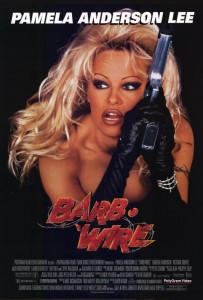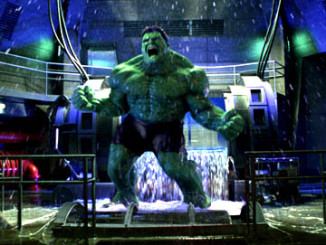In a multi-part series, Comic Book Film Editor William Gatevackes will be tracing the history of comic book movies from the earliest days of the film serials to today’s big blockbusters and beyond. Along with the history lesson, Bill will be covering some of the most prominent comic book films over the years and why they were so special. This time, we’ll continue our look at the comic book film adaptations of Dark Horse Comics titles in the 1990s.
 Dark Horse Comics came into being in 1986, right at the tail end of the same black and white boom that gave the Teenage Mutant Ninja Turtles their start. As a matter of fact, one of the two Dark Horse books at start up was Boris the Bear, a satire on the Turtles and all their imitators. The other book was Dark Horse Presents, an anthology which would go on to become one of their longest running titles. From the very start, Dark Horse showed itself to be a home for intriguing stories done by talented creators.
Dark Horse Comics came into being in 1986, right at the tail end of the same black and white boom that gave the Teenage Mutant Ninja Turtles their start. As a matter of fact, one of the two Dark Horse books at start up was Boris the Bear, a satire on the Turtles and all their imitators. The other book was Dark Horse Presents, an anthology which would go on to become one of their longest running titles. From the very start, Dark Horse showed itself to be a home for intriguing stories done by talented creators.
But doing good work was not enough to guarantee longevity, as many black and white publishers such as Eternity, Aircel, and Blackthorne were forced out of business as the boom went bust. Dark Horse was able to survive long enough to become one of the big four comic publishers today due to the savvy way they tapped the licensed comic book market.
Printing licensed comic books is a risky proposition for smaller comic book publishers. While a popular property will bring in readers, the rights are typically expensive. You’d have to pick up the right license to make sure it generated enough sales to make the fees you’d pay be worthwhile. Dark Horse played this market superbly, by licensing a number of film properties that others overlooked and doing things with them that no one had ever thought of before.
Dark Horse picked up the license for Aliens, Predator, Terminator, and RoboCop fairly early in its history. While all these properties spawned successful series that filled Dark Horse’s coffers, the company’s genius decision to pair the properties off with one another is what launched the company into the stratosphere. At the time, the idea that the half-man, half-robot RoboCop could face off against the human-looking killer robot Terminators would have only existed in the world of fanboy fantasy. Dark Horse made the idea a reality, and one of its combos, Alien vs. Predator, inspired a pair of feature films that we’ll cover later on.

The success of the above licenses allowed Dark Horse to pick up one of the most expensive, yet most lucrative, licenses around—the Star Wars license. What’s more, the comic book company was granted the honor by Lucasfilms to have all of the comics they published to be in the official Star Wars canon. This made the comics more attractive to the rabid Star Wars fan base, which improved sales and Dark Horse’s bottom line. It’s fairly safe to say that Dark Horse would not be the industry player it is today without the smart way they pursued its film licenses.
The journey between films and comics for Dark Horse worked both ways. Starting in 1994, Dark Horse became a presence on the big screen. Its first entry was The Mask, which we spoke about last time. That film was followed later in the year by Timecop.
 Timecop was based on a story in the Dark Horse Presents called “Time Cop,” which is based on a great premise—a government agency in a world where time travel is possible monitors the time travel system to make sure that the system is not abused for personal gain. When almost every conversation about time travel eventually comes to “I wish I could go back and buy that much valued collectible” or “If I could go back, I’d bet the farm on that sporting event where the heavily favored team lost,” creating a story out of the way to monitor the situation is pretty close to genius.
Timecop was based on a story in the Dark Horse Presents called “Time Cop,” which is based on a great premise—a government agency in a world where time travel is possible monitors the time travel system to make sure that the system is not abused for personal gain. When almost every conversation about time travel eventually comes to “I wish I could go back and buy that much valued collectible” or “If I could go back, I’d bet the farm on that sporting event where the heavily favored team lost,” creating a story out of the way to monitor the situation is pretty close to genius.
In a rarity for most comic book films but a common occurrence in the Dark Horse adaptations, Timecop was co-written by Mark Verheiden, who was the premise’s creator. Set in the year of 2004, when time travel is finally possible (HA!), the film stars Jean-Claude Van Damme, in one of his better roles, as Max Walker, one of the Time Enforcement Commission’s best agents However, when an investigation into a corrupt politician using time travel to gain more power and influence takes Walker back ten years to the night of his wife’s murder, he must struggle with whether or not to break the law he swore to uphold and save his wife.
The film was a box office success, making over $100 million dollars worldwide. In 2003, it generated a direct to video sequel, Timecop 2: The Berlin Decision.
 If Timecop was an encouraging sign as to how all Dark Horse Comics adaptations would work out, the next film in line would be a virtual cold shower towards that way of thinking. It started in 1993 when Barb Wire was created by Chris Warner as part of Dark Horse’s attempt at creating a shared universe with their “Comics’ Greatest World” imprint. She was a bounty hunter/bar owner who operated out of the Detroit-like “Steel Harbor” region of the imprint. Three years later, in 1996, the adaptation, Barb Wire, hit the big screen.
If Timecop was an encouraging sign as to how all Dark Horse Comics adaptations would work out, the next film in line would be a virtual cold shower towards that way of thinking. It started in 1993 when Barb Wire was created by Chris Warner as part of Dark Horse’s attempt at creating a shared universe with their “Comics’ Greatest World” imprint. She was a bounty hunter/bar owner who operated out of the Detroit-like “Steel Harbor” region of the imprint. Three years later, in 1996, the adaptation, Barb Wire, hit the big screen.
 The film, like Timecop, was set in the future (2017 in this case). It was also almost a shot for shot remake of Casablanca, with a new American Civil War in place of World War II, contact lenses that could confuse the Border Guard’s retinal scanners in lieu of the letters of transit, and Pamela Anderson in the Humphrey Bogart role (yes, read that again, Pamela Anderson replacing Humphrey Bogart).
The film, like Timecop, was set in the future (2017 in this case). It was also almost a shot for shot remake of Casablanca, with a new American Civil War in place of World War II, contact lenses that could confuse the Border Guard’s retinal scanners in lieu of the letters of transit, and Pamela Anderson in the Humphrey Bogart role (yes, read that again, Pamela Anderson replacing Humphrey Bogart).
Now, this tactic raises a lot of questions. Like, why did screenwriters Chuck Pfarrer and Ilene Chaiken decide to rip off one of the greatest films of all time for their dumb comic book adaptation? Were they lazy or just trying to be ironic? And who was it that thought that Pamela Anderson, the once and future Playboy Playmate, whose main claim to acting fame was filling out a one-piece, red bathing suit well enough to generate the proper jiggle factor when running down the beach in slow motion, was an adequate substitution for one of the best actors of any generation? Why even bring up that comparison in the first place? And was the character of Barb Wire that boring in the comics that you had to ape a great film just to make the character seem interesting? If so, then why make the movie at all?
The film was lambasted by the critics and was a box office bomb. Pamela Anderson would be relegated to cameos in a string of horrible parody films and a couple low-budget, forgettable comedies.
Barb Wire co-writer Chuck Pfarrer would bring Dark Horse back to the big screen three years later with Virus.
 Virus was based on a miniseries Pfarrer wrote for Dark Horse in 1993. The comic was, in turn, adapted from an unproduced screenplay of Pfarrer’s, bringing the project full circle.
Virus was based on a miniseries Pfarrer wrote for Dark Horse in 1993. The comic was, in turn, adapted from an unproduced screenplay of Pfarrer’s, bringing the project full circle.
The plot is basically a ghost ship tale with a sci-fi updating. A salvage ship comes across a Soviet research vessel in the South Pacific. Upon boarding, the salvage crew finds signs of a struggle but no bodies. They soon find out that the ghost vessel is home to an alien intelligence that is cannibalizing the ship and the corpses of the Russian crew to build an army to eradicate the human race.
The film was a critical and financial disappointment, earning just over $30 million worldwide against a $75 million budget. Jamie Lee Curtis, who starred in the film, called Virus the worst film she’s ever made. Considering her resume, that’s saying a lot.
We’ll cover another Dark Horse property–Hellboy–later on in the series. Next time, we cover the kid friendly publishers and their forays onto the silver screen.




